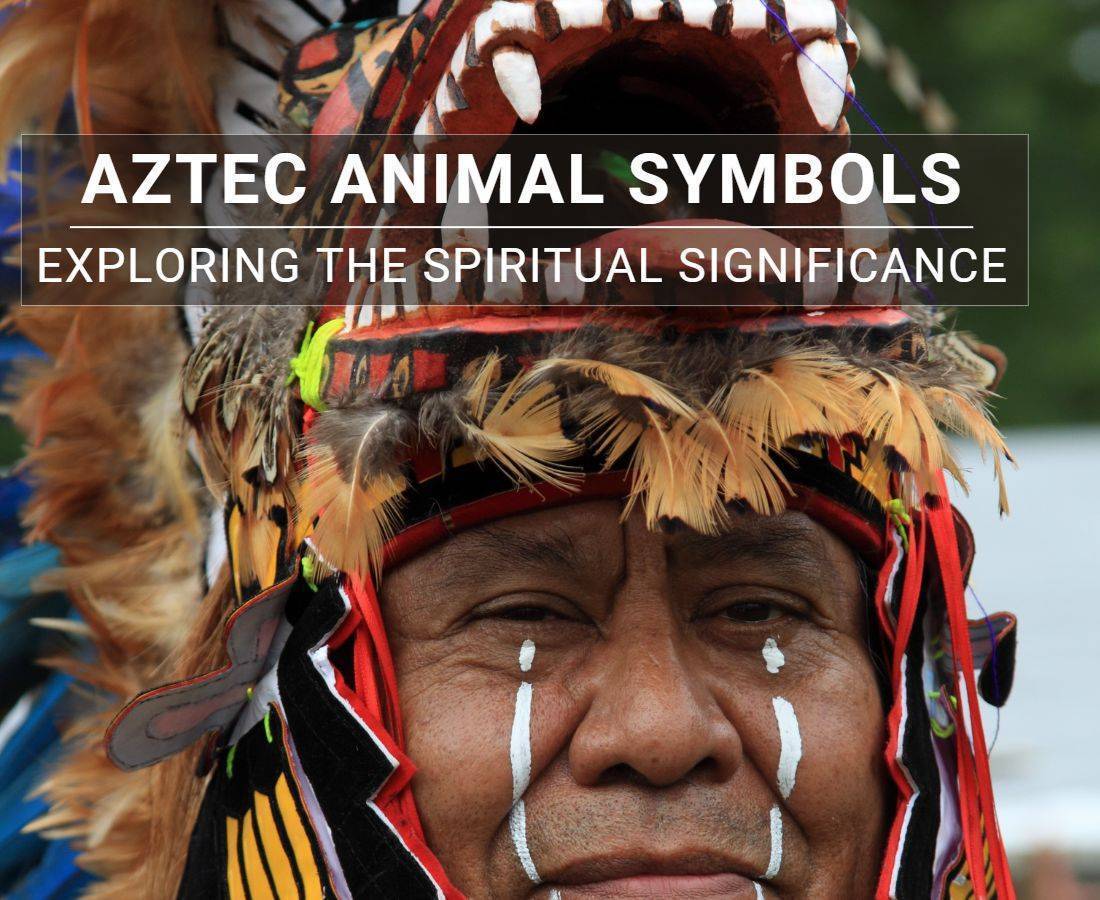Dive into the mesmerizing world of the Aztec civilization, where ancient Mesoamerica thrived with breathtaking art, awe-inspiring architecture, and mind-blowing astronomical and mathematical feats.
Table of Contents
The Aztecs, known for their elaborate calendar systems, marked the passage of time and commemorated significant religious and cultural milestones. But, what truly sets them apart is their elaborate use of animal symbolism – a captivating aspect that seamlessly wove its way into their mythology, religion, daily life, and even social hierarchy.
So, join us as we unravel the mysteries and impact of Aztec animal symbols, and discover how they continue to shape Mexican art and culture to this day. Get ready to be enchanted!
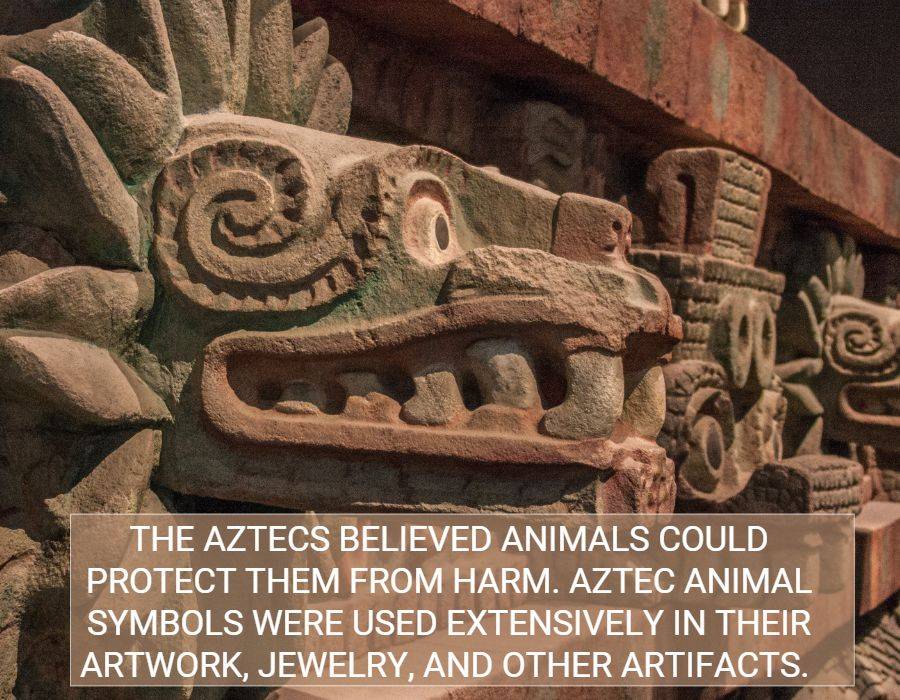
History of Aztec animal symbols
The Aztecs viewed these animals as sacred, observing their personality and traits and using their existence as meaning for their lives.
The Aztecs believed animals could protect them from harm. Aztec animal symbols were used extensively in their artwork, jewelry, and other artifacts.
Each animal had its symbolic meaning and was associated with different gods or goddesses. For example, the jaguar was considered a powerful animal representing strength and bravery. It was also associated with Tezcatlipoca, the god of night and sorcery.
These animal symbols were often depicted in intricate designs using bright colors to create beautiful works of art that still fascinate people today. The Aztecs had a deep reverence for animals and believed that they possessed spiritual power.
Over time, the concept of Aztec animal symbols has evolved to become more inclusive. Today, these symbols are no longer limited to traditional Aztec art or religious practices but have been incorporated into modern cultural expressions like fashion design and tattoo art.
Many people now use these symbols to connect with their heritage or express their love for nature.
The Aztecs practiced animal sacrifice to appease their deities, with a variety of animals offered at the Templo Mayor in Tenochtitlan. The esteem of the sacrifice was determined by the difficulty in capturing or hunting the animal.
The more challenging it was to obtain the animal, the greater the sacrifice was considered in the eyes of the Aztec people. This meant that animals such as jaguars, eagles, and coyotes, which were more difficult to catch, were considered more valuable as offerings to the gods than other, more easily obtainable animals.
On a side note it is important to know that alongside animal sacrifice, the Aztecs also practiced human sacrifice as part of their religious rituals. The practice involved the ritual killing of individuals, typically prisoners of war or slaves, as an offering to the gods. Human sacrifice was viewed as a necessary act to ensure the continued well-being of the Aztec people and their deities.
The symbolism of specific animals
The most common Aztec Animal Symbols are the jaguar, eagle, serpent, and dog.
Jaguar
The jaguar played an important role in Aztec mythology, often depicted in artwork and used as a ceremonial offering during religious rituals. Its symbolic significance extended beyond physical traits and represented royalty and authority. Jaguar skin was reserved for nobility to wear as clothing or adornments.
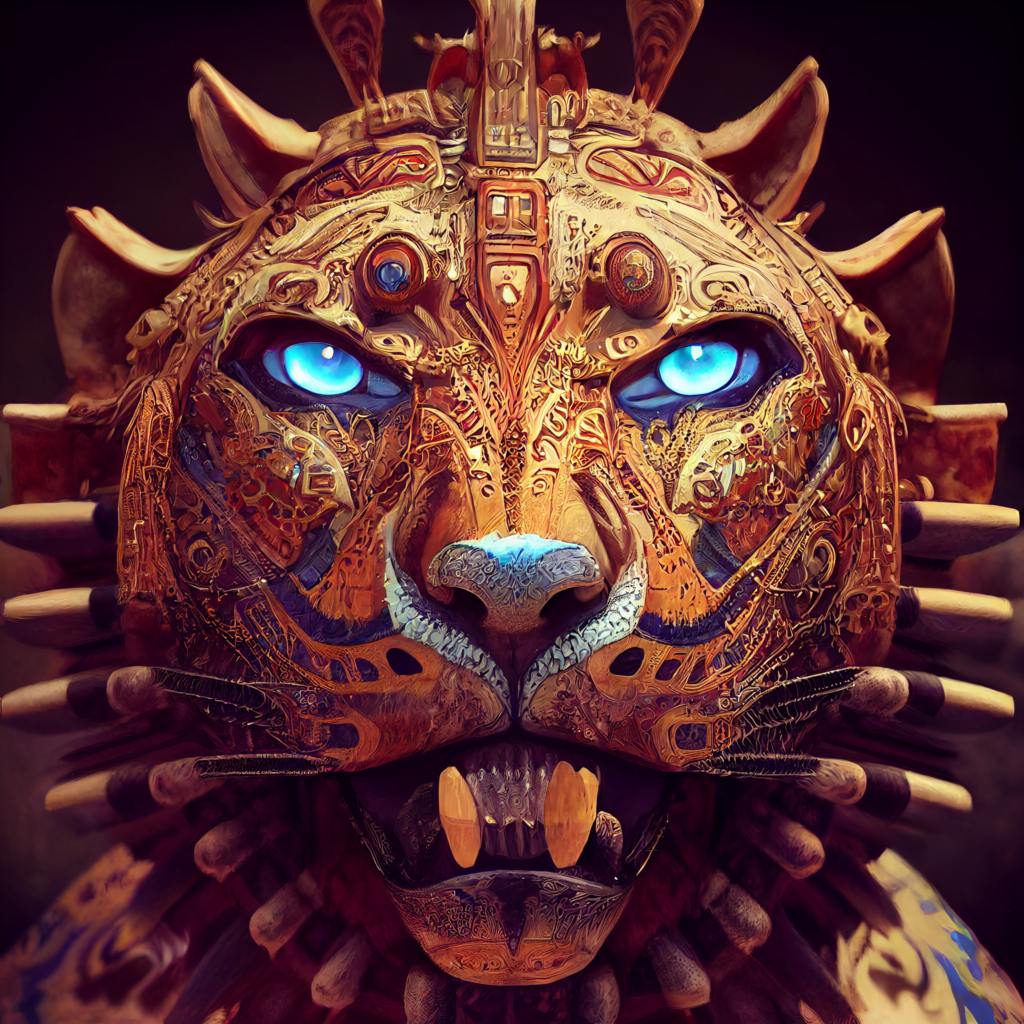
Despite this reverence for the animal, hunting jaguars was also seen as a rite of passage for young Aztec warriors. They would venture out into the jungle to fight and kill one with only their bare hands or basic weapons as part of their training to become skilled fighters.
Eagle
The eagle is a powerful symbol in Aztec culture. It symbolizes nobility, courage, and honor for its impressive hunting skills and majestic presence.
The Aztecs believed that eagles were messengers between the gods and humans, a belief that has persisted to this day. In addition to being a spiritual icon, the eagle was an important military symbol for the Aztecs.
Warriors would wear eagle feathers in their headdresses as a sign of their bravery and strength on the battlefield. The powerful image of an eagle soaring through the sky with its sharp talons ready to strike made it a formidable emblem of war.
Today, the eagle continues to be celebrated as a symbol of strength and resilience across many cultures worldwide. Its regal bearing inspires people striving to live up to its noble qualities of courage, honor, and grace under pressure. The eagle remains an enduring emblematic figure representing power and prestige wherever it is found.
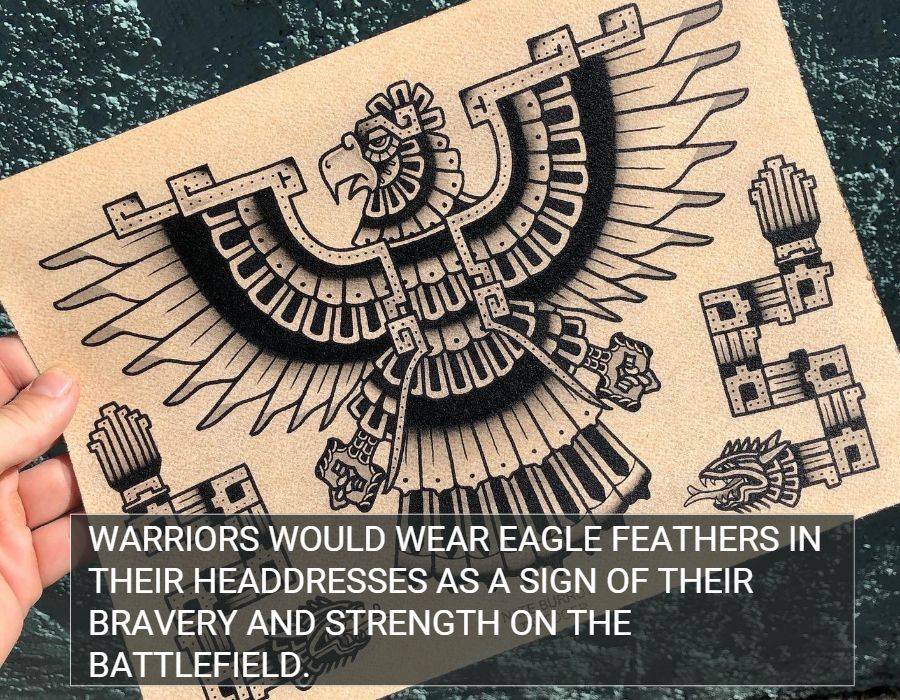
Serpent
Serpents hold a significant place in Aztec mythology and culture. They were seen as an embodiment of wisdom, fertility, sensuality, and rebirth and were a symbol of power.
The serpent god Quetzalcoatl was one of the most important deities for the Aztecs, associated with creation, enlightenment, and knowledge. His name means “feathered serpent,” indicating his connection to the sky and the earth.
Serpents also had practical uses in Aztec society. Due to their perceived healing properties, they were often used as divination tools or for medicinal purposes.
The Mesoamerican ballgame, a popular sport among Aztecs and other ancient civilizations in the region, featured a rubber ball that was sometimes decorated with serpents as a symbol of fertility.
Dog
Dogs were highly esteemed for their loyalty and resilience. They were often used as symbols of these traits in artwork and storytelling, emphasizing the importance of these virtues to the Aztecs.
Dogs were also considered neutral beings, able to traverse between different worlds without taking sides. The Aztecs believed dogs had a great sense of direction and could guide lost souls through the underworld.
This further added to their symbolism as protectors and guides. There was even a deity associated with dogs named Xolotl, who was seen as a protector of both humans and animals. See more about the spiritual meaning of the dog.
Rabbit
The rabbit was considered a symbol of longevity, wisdom, creativity, the afterlife, childbirth, and swiftness. This belief stemmed from their observation of rabbits’ behavior in nature.
Rabbits are known for their ability to reproduce rapidly and survive harsh environments, symbolizing longevity. The Aztecs also believed that rabbits had special wisdom as they could easily avoid predators and navigate through difficult terrains.
The rabbit’s speed made it an important symbol in Aztec culture. The Aztecs believed that swift animals were powerful and could outrun danger. Because rabbits are fast runners with great agility, they become associated with this power and strength.
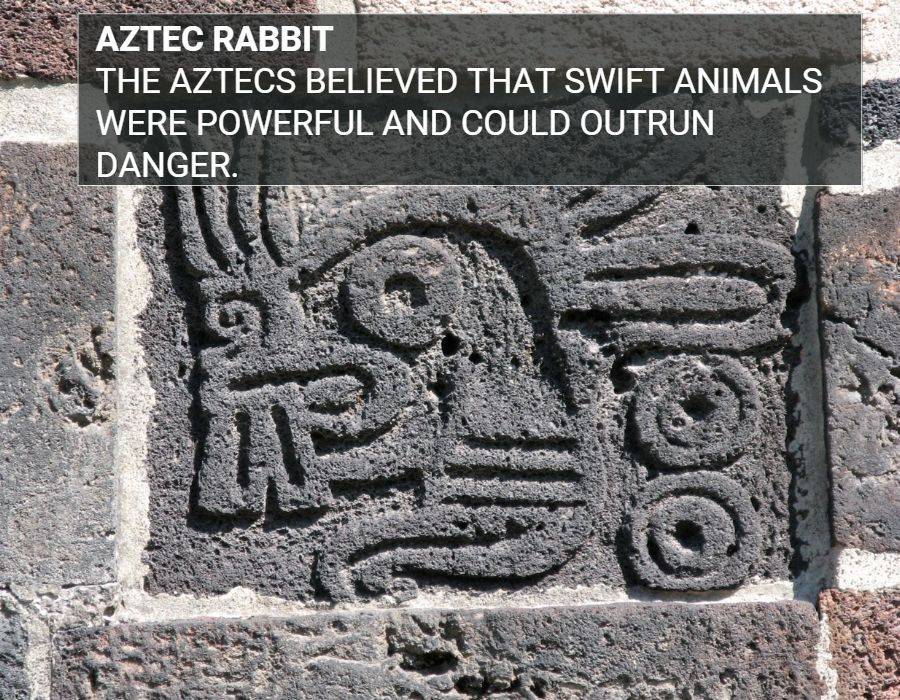
The Owl
Who’s guiding you through the afterlife? For the Aztecs, owls held a vital role! These wise birds not only symbolized death and the underworld, but they also helped guide wandering souls. The owl was also associated with the god of death and was often depicted in Aztec art as an ominous and foreboding creature.
Embodying both wisdom and the uneasy mystery of death, owls were revered by Aztec scholars and priests, making them a truly compelling emblem of their culture.
Hummingbird
The hummingbird played a significant role in Aztec mythology and was associated with the god of war, Huitzilopochtli. According to Aztec beliefs, the hummingbird was believed to be the reincarnation of fallen warriors and was revered for its courage and fighting spirit.
In Aztec art, the hummingbird was often depicted as a symbol of the warrior class and was used to represent bravery and nobility. The hummingbird’s swift and agile movements also made it a symbol of speed and agility. Its importance in Aztec culture was further emphasized by its association with Huitzilopochtli, who was considered one of the most important gods in the Aztec pantheon.
Buttery
The Aztecs believed that butterflies were the souls of warriors who had died in battle and had been transformed into these beautiful creatures. They also associated them with the goddess Xochiquetzal, who represented fertility, transformation, beauty, and love.
Aztec art and literature often depicted the butterfly as a symbol of peace, beauty, and grace. Its delicate wings were seen as a metaphor for the fleeting nature of life itself. This symbolism is still present today in Mexican folk art, where vibrant patterns of butterflies adorn traditional textiles.
Aztec animal symbols in modern Mexico
These animal symbols represented different qualities and characteristics that the Aztec people admired. For example, the hummingbird was a symbol of fertility and abundance.
These Aztec animal symbols are still widely used in contemporary Mexican culture. They can be found on everything from clothing to home decor to tattoos. Many people choose to incorporate these symbols into their lives to connect with their cultural heritage or express themselves artistically.
Click to see our post about Mexican animal symbols.
Conclusion
In the Aztec civilization, different animals were believed to have significant spiritual meaning and symbolism. The Aztecs often depicted animals in art, architecture, and religious rituals. They believed animals held the keys to unlocking their own potential and provided spiritual truths from the universe.
Animal symbolism was a powerful tool for expressing complex ideas and emotions within the Aztec culture. By assigning different meanings to each animal, the Aztecs communicated important values such as courage, wisdom, and loyalty through their artwork and traditions.
Check out this video for more information on Aztec symbolism!
FAQ
What animal represents the Aztecs?
The Aztecs revered a multitude of animal symbols, each embodying distinct qualities and attributes. Prominent among these were the fierce jaguar, symbolizing power and strength; the mighty eagle, denoting courage and wisdom; the enigmatic serpent, embodying duality and transformation; and the wise owl, epitomizing guidance and foresight. These creatures featured heavily in Aztec art, architecture, and mythology, reflecting their sacredness and indispensable roles in religious beliefs and rituals.
What animal is associated with Aztec warriors?
The hummingbird is the animal most commonly associated with Aztec warriors. According to Aztec beliefs, the hummingbird was believed to be the reincarnation of fallen warriors and was revered for its courage and fighting spirit. In Aztec art, the hummingbird was often depicted as a symbol of the warrior class and was used to represent bravery and nobility.
Did the Aztecs have a sacred animal?
The Aztecs revered various sacred animals, embodying essential aspects of their religion and culture. The majestic jaguar represents the fierce Tezcatlipoca, the mighty eagle embodying the sun god Huitzilopochtli, the mysterious serpent symbolic of the rain deity Tlaloc, and the wise owl associated with the goddess of death, Mictecacihuatl, were integral to Aztec mythology. These spiritually potent creatures were believed to be divine emissaries, capable of bridging the Aztecs’ communication with their myriad gods and goddesses.
What animal represents the sun in Aztec?
The Aztecs revered the sun, symbolized by two animals: the majestic eagle, delineating the sun’s diurnal presence, and the powerful jaguar, epitomizing its nocturnal embodiment. Envisioned as the celestial orb’s guardians, both creatures frequently adorned Aztec art and architecture, exemplified in the striking Calendar Stone, which prominently showcases the eagle and jaguar as essential emblems within their intricate cosmological, spiritual, and historical belief structures.
